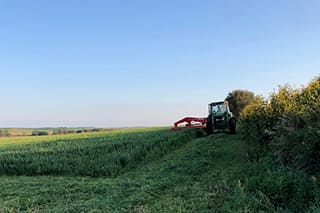Alfalfa Insect and Nutrient Management
Jun 06, 2023

Written by Agronomy Manager, Bryan Hoffman.
Last year I wrote about this same topic. However, with the current value of alfalfa being quite high I thought it was a very timely subject again. A couple of the pests to watch for are alfalfa weevil and aphids. Scouting for these insects is a must and your Farmers Pride Agronomist can help you look at your alfalfa fields for any pest presence and if a spray application is warranted.
When we look at regrowth and helping alfalfa produce tons per acre, we have some programs that have been very beneficial in the past. Making a dry fertilizer application after the first cutting is one that is commonly used. Appling 5 gallons of Triple Nickel (8-20-5-5-.5) and ½ pint of 10% Liquid Boron with 15 gallons of water per acre to enhance regrowth after the first cutting. Another nutritional option to consider is a bio stimulant fertilizer, called Kriss, which has a 5-8-4 analysis and combines seaweed extracts and plant-based amino acids to help drive yield, increase feed quality, and defend against plant stress. Using a biological called Ascend SL that has gibberellic acid can help boost the plants regrowth.
We have talked for years about plant health with a fungicide in other crops like corn and soybeans, it only stands to reason that the addition of one in alfalfa (a plant that the leaf quality determines the hay quality) would be beneficial also.
Scouting
UNL Extension offers the following advice on alfalfa scouting. Alfalfa weevil damage consists of small holes and interveinal feeding on the newest leaflets near the stem tips. The larvae are small (1/16 to 3/8 inch-long) and pale yellowish green, becoming a daker green when larger. These legless worms have black heads and a white stripe the length of the back. The alfalfa weevil larvae spend nearly all their time on the plant. They curl into a C-shape when disturbed. In the spring, pea aphids are often present in alfalfa fields at the same time as the alfalfa weevils. As aphids feed on alfalfa, they inject a toxin into the plant. This toxin can have damaging effects on plant growth. Once the alfalfa is high enough to use a sweep net, take a sample to establish whether weevils and aphids are present. If they are, randomly select at least five sapling sites from across the entire field. At each site, gently pick or cut at least 10 alfalfa stems at ground level. Shake the larvae off the stems by beating the stems into a deep-sided bucket. Count the larvae and determine the average number of larvae per stem. Make sure to check for small larvae that may be enclosed in new, folded leaflets at the tips of the stems. Measure stem lengths and determine the average stem height.
Economic thresholds have been developed to aid decision making on alfalfa weevil control. These thresholds were derived by North Dakota State University entomologists (Beauzay et al. 2013) from a two-year study conducted at the UNL Eastern Nebraska Research, Extension and Education Center near Mead in 1990 and 1991 (Peterson et al. 1993). These guidelines can fluctuate depending on growing conditions and variety. Deciding whether to treat or re-sample depends on the average number of weevils per stem, the stem length, treatment costs, and the value of the alfalfa. When alfalfa reaches 50% or more bud stage, it may be more profitable to cut the alfalfa earlier than treat it.